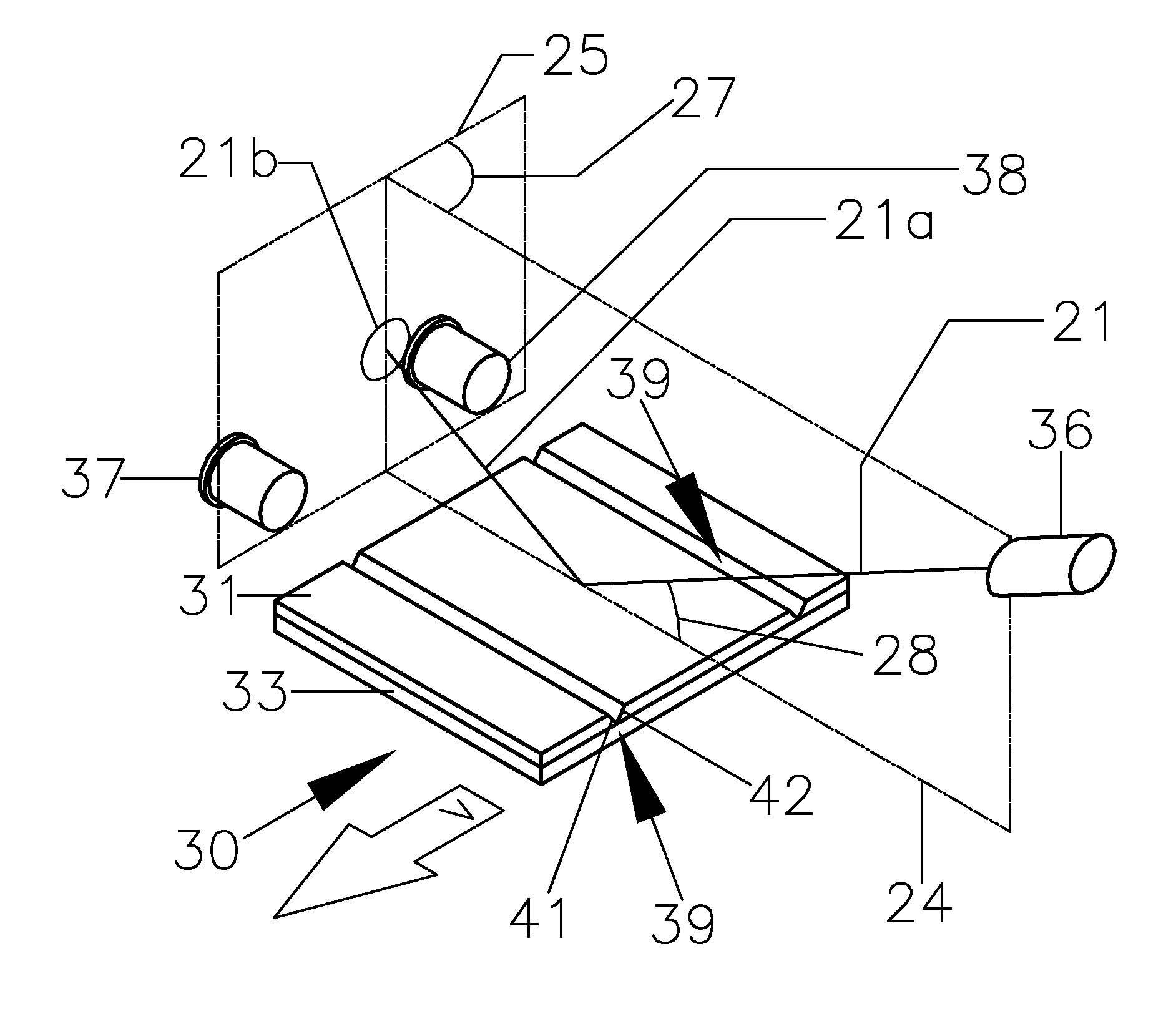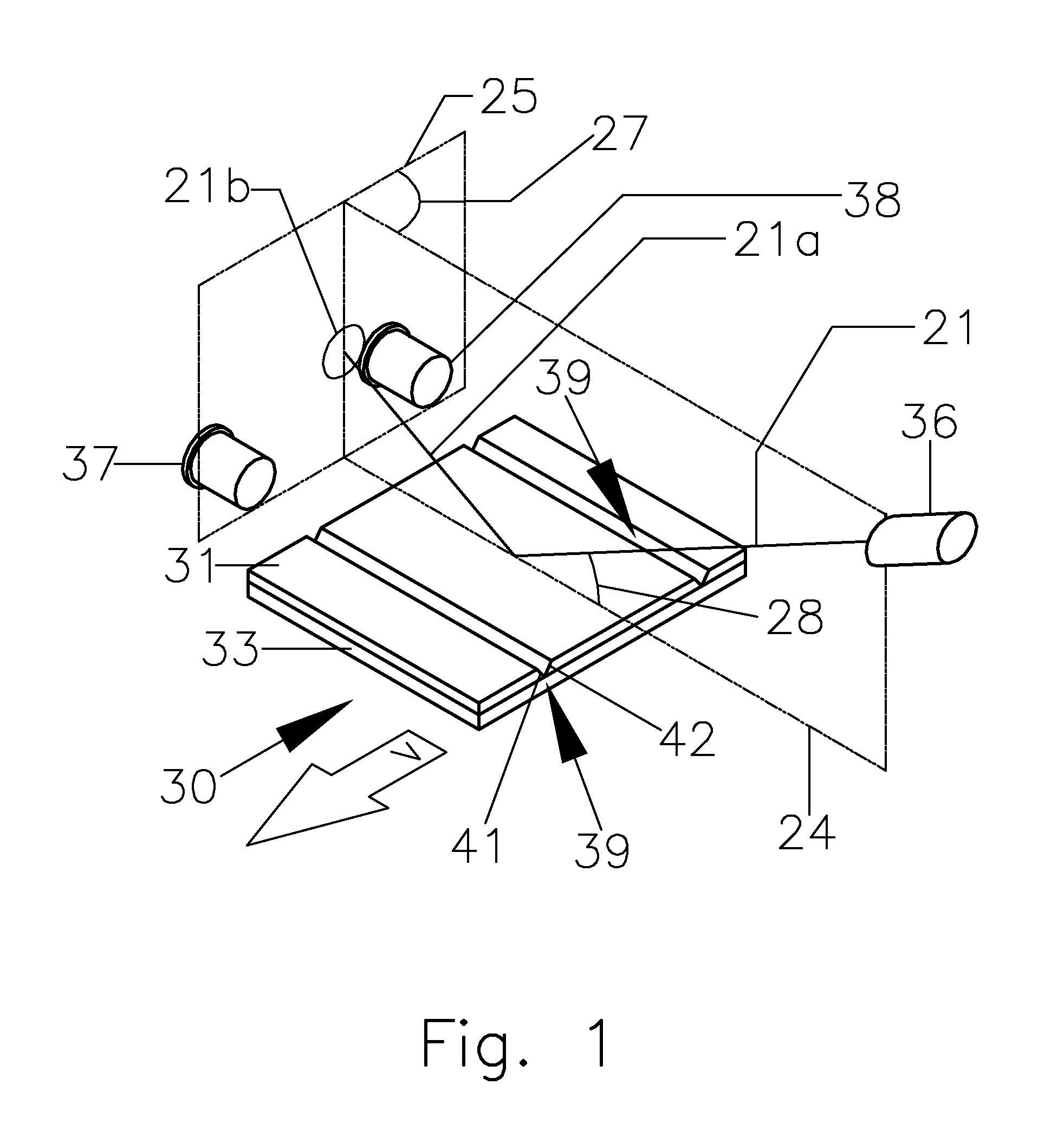Label edge detection using out-of-plane reflection
- Summary
- Abstract
- Description
- Claims
- Application Information
AI Technical Summary
Benefits of technology
Problems solved by technology
Method used
Image
Examples
first embodiment
[0089]FIG. 3 shows parts of the first embodiment of a sensor designed to use out-of-plane reflection of light off label edges to detect the location of die-cut labels.
[0090]In FIG. 3 there is a light source 36 that emits a small beam of light whose direction is represented schematically in this disclosure by an incident ray 21. Hereafter in this disclosure, the entire beam of light will be referenced as incident ray 21. Light source 36 may include some parts not shown, including (for example) a light-emitting or laser diode and whatever optical components are required to shape the light from that diode into a small light beam. Those parts are not shown, because the use of light-emitting and laser diodes, lenses, fiber optic cables, light guides, apertures, windows, etc. to produce light beams is well-known to those experienced in the art.
[0091]Experimentation has shown that if incident ray 21 is about 0.5 mm (0.02 inch) in diameter, it will work with label material that is 0.069 mm ...
second embodiment
[0114]FIGS. 6 and 7 show a possible alternative embodiment of the label sensing method, the only structural difference being that angle 27 is no longer 90°. The detection plane is still parallel to the direction of motion of web 30.
[0115]In the first embodiment, the light pattern formed in detection plane 25 by the various light beams that are reflected off flat surfaces and edges tends to be generally symmetrical on both sides of initial incidence and reflection plane 24. But due to the asymmetry of this arrangement, light spots 22a and 23a will no longer be symmetrical.
[0116]This embodiment as shown in FIG. 7, with angle 27 greater than 90°, may be useful at some point. But it may enhance the detection of leading edge 42 at the cost of worse detection of trailing edge 41. As angle 27 gets increasingly larger than 90°, trailing edge 41 will tend to be more and more in a shadow, and could at some value of angle 27 become undetectable if incidence angle 28 is sufficiently small. This...
third embodiment
[0118]FIG. 8 illustrates a third embodiment that's simplified from the preceding examples. It shows the label-edge position at which leading edge 42 is detected. It uses only photodetector 37 instead of two photodetectors. This still enables the sensor to detect the leading label edges 42 of both butt-cut and die-cut labels. If one wanted to detect trailing label edges 41 instead, then photodetector 37 would be omitted and photodetector 38 would be used instead, and it would be positioned as shown in FIGS. 1-7. This embodiment would still detect the edges of both die-cut and butt-cut labels, but it wouldn't know which of the two kinds of labels it was sensing, and would be unable to tell which direction web 30 was moving.
PUM
 Login to View More
Login to View More Abstract
Description
Claims
Application Information
 Login to View More
Login to View More - R&D
- Intellectual Property
- Life Sciences
- Materials
- Tech Scout
- Unparalleled Data Quality
- Higher Quality Content
- 60% Fewer Hallucinations
Browse by: Latest US Patents, China's latest patents, Technical Efficacy Thesaurus, Application Domain, Technology Topic, Popular Technical Reports.
© 2025 PatSnap. All rights reserved.Legal|Privacy policy|Modern Slavery Act Transparency Statement|Sitemap|About US| Contact US: help@patsnap.com



